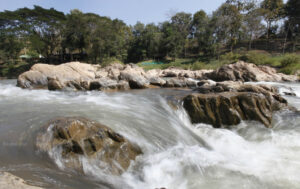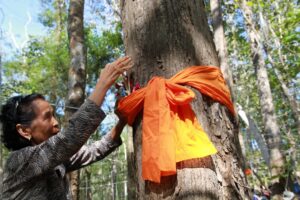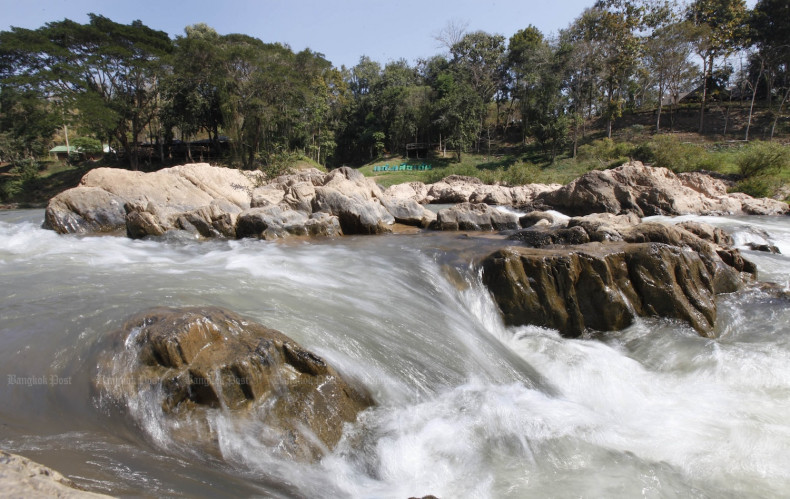
Baht200bn water management plan revived to mitigate severe flooding in the Yom River basin in Northern Thailand
Controversial proposal for Kaeng Sua Ten dam megaproject in Phrae could be back on the table
The government will revive a 200-billion-baht water management project to mitigate severe flooding in the Yom River basin in the North, with construction of a controversial Kaeng Sua Ten dam being raised once again.
Phumtham Wechayachai, the caretaker deputy prime minister, said on Saturday that he plans to propose that the cabinet consider placing water improvement on the national agenda with a budget of 200 billion baht.
The plan was initiated more than a decade ago by the Yingluck Shinawatra government but was interrupted by the coup in 2014.
The Yom River has its source in the Phi Pan Nam Range in Pong district of Phayao province. After Phayao, it flows through Phrae and Sukhothai as the main water resource of both provinces before it joins the Nan River at Chum Saeng district of Nakhon Sawan.
“If the people agree, we [the government] would reconsider the plan to ensure that the Yom River has flood storage areas like the Ping, Wang and Nan rivers,” Mr Phumtham said on Saturday before distributing 200 relief bags to flood-affected residents in Sukhothai province.
“For those who oppose it, I urge them to talk with those who have been enduring floods their whole lives, as their voices matter.”
When the Yingluck government first considered the idea in 2011, a budget of 2–3 trillion baht was estimated for the entire project. The cost today could be 5–6 trillion.
Former prime minister Thaksin Shinawatra told a local forum last week that the new government needs to undertake a number of “megaprojects” during the rest of its term, especially to address the country’s chronic flooding and drought problems.
Plodprasop makes the case
The Kaeng Suea Ten Dam should be built in Phrae to prevent flooding in the North, argues Plodprasop Suraswadi, a former Royal Forestry Department chief who also served as a deputy premier in the Yingluck government.
Writing on his Facebook page on Saturday, Mr Plodprasop said that 500 to 700 millimetres of rain fell in just five days in Phayao, Nan and Phrae, or about 5 billion cubic metres of water.
He said this water flowed through the Yom River in Phrae at a rate of 1,700 cubic metres per second.
However, when the water reached Sukhothai, authorities chose to build soil barriers or concrete walls along the riverbanks with almost no structural reinforcement, especially at the foundation.
He said these walls might protect the community from flooding should the water is not too high. But if the water level rises above the walls, it is impossible to control the overflow.
Strong currents, especially at river bends, have caused the walls to crack in multiple spots along the Yom River in Sukhothai. If the walls collapse, which could happen at any time, it can cause great damage and danger to the community, he said.
Mr Plodprasop argued that it is crucial to push for a water diversion project using the Had Saphan Chan water gate, along a 30-kilometre distance, within the next year. Otherwise, the same kind of flooding will happen again next year.

“As for Phrae, I believe it is necessary to build the Kaeng Suea Ten Dam because we can no longer leave the Yom River uncontrolled,” he wrote.
Many risks to consider
Hannarong Yaowalers, chairman of the Foundation for Integration of Water Management, disagrees with the idea of building such a dam.
“Anyone believing the Kaeng Suea Ten Dam should be built must understand the issue first,” he said.
The most recent plan for the dam called for it to hold 1,175 million cubic metres of water, based on a feasibility study that showed a possible flood area of 45,625 rai.
However, he said academic research has suggested the flooded areas could cover as much as 65,625 rai.
A 20,000-rai gap was too much [to not reconsider], he said.
Back in 1995, he said, the National Environment Board identified four major issues that needed further study.
They were earthquake risk, social impact, public health facilitation and environmental impacts relating to the Kaeng Suea Ten Dam project, none of which have been resolved.
Therefore, he said, in order to push forward the dam project a new study must be conducted as the latest one is over 30 years old and all the social, economic and ecological data have changed.
He suggests that authorities conduct public hearings to listen to local voices.
“Nowadays, communities have become stronger. Local people are much more knowledgeable, equipped with information, and don’t want to relocate,” he said.
Caretaker Public Health Minister Somsak Thepsutin, meanwhile, suggested Sukhothai should have a large dam as the province often faces floods.
He said the Yom River in Si Satchanalai district can handle a flow 1,900 cubic metres per second, but by the time it reaches Sukhothai, the river can only handle 500 cubic metres per second.
Source: https://www.bangkokpost.com/thailand/general/2857158/b200bn-water-management-plan-revived


